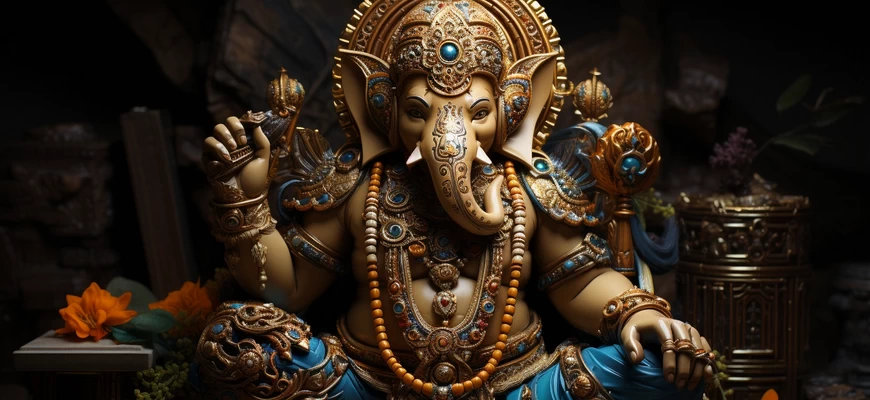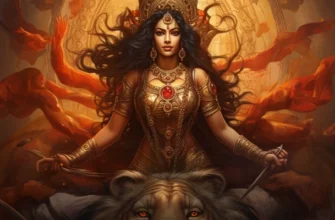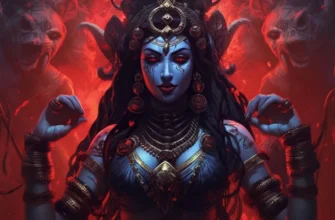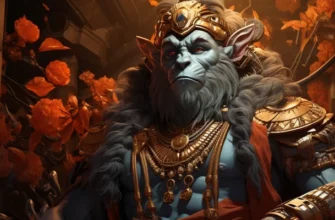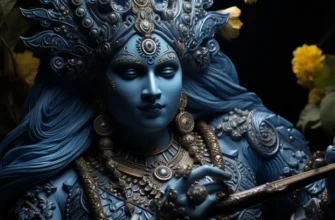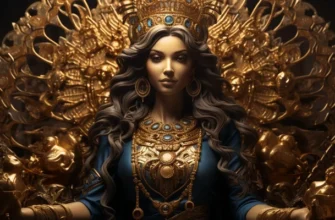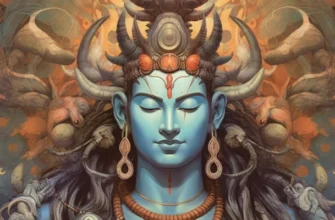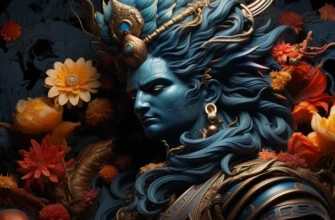Ganesha is the god of wisdom and happiness in Indian mythology. He is depicted as a man with an elephant’s head. He is revered as the patron saint of beginnings and obstacles, often invoked during important endeavors. He symbolizes intelligence, wisdom and the ability to overcome obstacles.
Ganesha is the Indian god of wisdom, success, and good fortune, often revered as the patron saint of beginnings and the taming of obstacles in Indian mythology. His presence in Indian culture and religion is an important element symbolizing wisdom and spiritual wealth.
- Legends and myths
- Symbols and attributes
- The cult of Ganesha
- Role in Modern Society: The influence of Ganesha on contemporary Indian culture and society.
- The spread of the Ganesha cult
- Ganesha’s influence on Indian art, architecture and literature.
- Widespread acceptance in the world: the spread of the Ganesha cult outside India.
- Conclusion
Legends and myths
The legends and myths associated with Ganesha are varied. One of them tells how Ganesha got his elephant’s head: as a result of a misunderstanding between his father, the god Shiva, he lost his head and it was replaced with an elephant’s head. Other legends emphasize his wisdom and ingenuity, which were used to overcome great obstacles in mythical stories.
Ganesha has many legends and myths, including some of the most famous ones:
The Origin of Ganesha: The legend of his birth from god Shiva and goddess Parvati, and how he got his elephant head.
The legend of Ganesha’s origin explains how he was born of god Shiva and goddess Parvati. According to the myth, when Parvati created Ganesha from her body, she instructed him to guard the entrance to her bedroom. When Shiva, her husband, tried to enter, Ganesha did not let him in, not recognizing his father. Shiva’s anger was aroused, and he cut off Ganesha’s head. After that, Shiva, in order to calm down the angry Parvati, restored Ganesha’s head, replacing it with an elephant’s head, giving him a unique look. Thus, Ganesha became an elephant-headed god, symbolizing wisdom and destiny.
The legend of the obstacle: The story of how Ganesha used his wisdom and ingenuity to overcome the difficult challenges that stood in his way.
The legend of the obstacle is related to Ganesha’s ingenuity and wisdom. According to the myth, he faced numerous difficulties and challenges during his travels. Thanks to his incredible ingenuity and smart decisions, he was able to overcome even the most difficult obstacles. This legend emphasizes his great strength of mind and ability to overcome any difficulty through intelligence and ingenuity.
Ganesha and his exploits: Various stories about his exploits that are included in Indian epic myths and legends.
The legends of Ganesha’s exploits encompass his great deeds and actions in fighting demons and other evil forces that threatened the world. His ingenuity and strength of mind helped him overcome the most difficult obstacles and defeat his enemies using his wisdom and resourcefulness. These legends show Ganesha as a powerful defender of goodness and justice, using his powers to protect the world from evil.
The legend of Ganesha and his exploits tells of the various deeds and achievements of the god. These exploits may include stories such as:
The Search for Maharabata: Ganesha sets out to find the holy book Maharabata, which has been lost in historical texts. He finds sometimes the most difficult passages and solves puzzles to recover the text.
The task of the gods: In other myths, Ganesha helps other gods with important tasks, fulfilling their suggestions and unraveling difficult situations.
Deliverance from evil forces: He also acts as a protector against negative forces, destructive forces of nature, and other threats, helping to maintain harmony and order in the world.
Creating amulets: In some stories, Ganesha creates amulets that bring good luck and protect against negative influences.
These legends and feats of Ganesha emphasize his great power and important role in Indian mythology and religion.
Ganesha’s Role in Family Life: Legends that emphasize his influence on family life and the relationship between parents and children in Indian mythology.
The legend of Ganesha’s role in family life touches upon important aspects of his relationship with his parents and other gods. According to this legend, Ganesha is famous for his passionate love for his parents, the god Shiva and the goddess Parvati. His respect, obedience, and devotion set an example for others and reflect the importance of family ties in Indian society. The legend also emphasizes how he uses his wisdom and intelligence to resolve family conflicts and maintain family harmony.
This legend teaches us about the importance of respecting and honoring family ties, and about happy and harmonious family relationships. Ganesha is an example of great respect and family unity, emphasizing that the family is the foundation of life and an important part of Indian culture.
These legends play an important role in shaping the cultural and religious perceptions of Ganesha in Indian society.
Symbols and attributes
Ganesha has numerous symbols and attributes that define him in Indian mythology:
Elephant’s head: Ganesha’s elephant head symbolizes wisdom, intelligence, and knowledge. It also indicates his great strength and ability to overcome great obstacles.
Thus, in Indian mythology, Ganesha’s elephant head symbolizes wisdom, intelligence, and knowledge. This feature emphasizes his great wisdom and ability to understand the essence of things. In many stories, his elephant head acts as a symbol of his intelligence and spiritual enlightenment, emphasizing his great importance in Indian culture.
A bag of goodies: This attribute symbolizes the influx of wealth and prosperity. Ganesha is often the patron saint of commerce and business, and the bag of goodies emphasizes his influence on material success.
This symbol indicates his influence as the patron saint of commerce, business and material success. The bag of goodies also reflects his ability to bring joy and pleasure to his supporters and loyal worshippers.
Lotus: The lotus, which is often depicted next to Ganesh, indicates his purity and spiritual highness, and also symbolizes grace and beauty.
In Indian culture, the lotus is a symbol of purity, enlightenment, and spiritual development. The presence of the lotus next to Ganesha also emphasizes his connection to higher spiritual forces and his ability to achieve inner harmony and peacefulness.
These symbols and attributes of Ganesha help to emphasize his greatness and importance in Indian culture, reflecting him as the god of wisdom, success, and happiness.
The cult of Ganesha
The cult of Ganesha plays an important role in Indian culture and includes religious rituals, worship, and veneration of the god. People pray to Ganesha for intelligence, wisdom, success, and good luck, as well as for removing obstacles to achieving goals. His role as the patron saint of art, science, commerce, and harmony is recognized and revered in various spheres of Indian society. Ganesha worship includes various rituals, prayers, celebrations and the construction of temples dedicated to him.
Religious rites and worship: practices associated with the worship of Ganesha in Indian culture.
Religious rituals and worship associated with the veneration of Ganesha in Indian culture include a variety of practices, such as:
Performing a puja: This is a religious rite that includes prayers, rites, and sacrifices performed in temples or at home to honor the god.
Celebrating festivals: Festivals dedicated to Ganesha, such as Ganesha Chaturthi, are important events in the Indian calendar during which religious rituals, parades, and festive events are held.
Visiting temples: Believers often visit temples dedicated to Ganesha to pray, worship, and perform rituals to help attract his blessings and protection.
Recitation of sacred texts: People also recite sacred texts dedicated to Ganesha to gain spiritual insight and spiritual development.
These practices reflect the importance and profound significance of the Ganesha cult in Indian religious life and culture.
Role in Modern Society: The influence of Ganesha on contemporary Indian culture and society.
The role of God Ganesha in modern Indian society is extremely important and widely recognized. He remains an important symbol of wisdom, success and prosperity, giving individuals confidence and faith in achieving their goals. Its image and symbolism permeate various areas of Indian life, including literature, art, business, and religious rituals. He remains an integral part of India’s cultural heritage and identity, contributing to the development of inner strength and self-confidence in modern society.
The spread of the Ganesha cult
The cult of Ganesha is widespread not only in India, but also in many other countries around the world where Indian traditions are followed and studied. His influence is manifested in architecture, art, literature, and music, which reflect his symbolism and significance. Outside of India, his cult attracts devotees and those interested in learning about the great heritage of Indian culture and religion. This allows for cultural exchange and understanding between different cultures, enriching the world heritage of humanity.
Ganesha’s influence on Indian art, architecture and literature.
Ganesha has a significant influence on Indian art, architecture and literature. His image and symbolism are reflected in various aspects of Indian creativity:
Art: Ganesha’s image is often reflected in Indian art, including painting, sculpture, and religious icons. He is depicted in a variety of poses and styles reflecting his various aspects, from wisdom to success.
Architecture: Ganesha is often incorporated into architectural elements, especially in temples and shrines. His image may appear on the facades of buildings or carved into walls, symbolizing his presence and protection.
Literature: Legends and stories related to Ganesh are often included in Indian literature. They tell of his exploits and influence on people’s lives, which gives them a deep spiritual meaning.
Ganesha’s influence on art, architecture, and literature reflects his important place in Indian culture and gives creative works deep meaning and spiritual richness.
Widespread acceptance in the world: the spread of the Ganesha cult outside India.
The cult of Ganesha is widespread outside of India and is important in the global context. His image and symbolism attract the attention and interest of people in different countries and cultures. Here are a few aspects that determine the spread and significance of Ganesha worship on a global scale:
Spiritual influence: Ganesha is the god of wisdom, intelligence, and success, and his image is valued not only in Indian religion but also in any spiritual quest. He gives strength and faith to those seeking spiritual balance.
Cultural exchange: The spread of Indian traditions and philosophy contributes to global cultural exchange. People of all nationalities study Indian art, music, traditions, and poetry, where the symbolism of Ganesha often finds its place.
Popularity of festivals: Festivals dedicated to Ganesha, such as Ganesha Chaturthi, are celebrated in different countries. They include celebrations, prayers, and religious rituals that attract the attention of both Indians and other citizens.
A symbol of success and prosperity: Ganesha has become a symbol of success, and his image is widely used in business, marketing, and financial matters. He is considered the protector of commerce and trade.
In general, the cult of Ganesha arouses interest and veneration in the global community, and its symbolism gives reliability, intelligence and spiritual depth to those who accept it in their lives.
Conclusion
God Ganesha stands as an important symbol of wisdom, intelligence, and spiritual wealth that has a significant impact on modern society and culture. His image and significance are reflected in various aspects of Indian life and also find their place in the global context. He provides faith and reliability to those seeking wisdom and success, and his symbolism remains an important source of inspiration and spiritual strength for many in the modern world. His cult and legends continue to generate interest and veneration in society, underscoring his important role in world culture.
